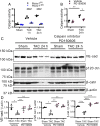Endothelial cell Piezo1 mediates pressure-induced lung vascular hyperpermeability via disruption of adherens junctions
- PMID: 31186359
- PMCID: PMC6600969
- DOI: 10.1073/pnas.1902165116
Endothelial cell Piezo1 mediates pressure-induced lung vascular hyperpermeability via disruption of adherens junctions
Abstract
Increased pulmonary microvessel pressure experienced in left heart failure, head trauma, or high altitude can lead to endothelial barrier disruption referred to as capillary "stress failure" that causes leakage of protein-rich plasma and pulmonary edema. However, little is known about vascular endothelial sensing and transduction of mechanical stimuli inducing endothelial barrier disruption. Piezo1, a mechanosensing ion channel expressed in endothelial cells (ECs), is activated by elevated pressure and other mechanical stimuli. Here, we demonstrate the involvement of Piezo1 in sensing increased lung microvessel pressure and mediating endothelial barrier disruption. Studies were made in mice in which Piezo1 was deleted conditionally in ECs (Piezo1iΔEC ), and lung microvessel pressure was increased either by raising left atrial pressure or by aortic constriction. We observed that lung endothelial barrier leakiness and edema induced by raising pulmonary microvessel pressure were abrogated in Piezo1iΔEC mice. Piezo1 signaled lung vascular hyperpermeability by promoting the internalization and degradation of the endothelial adherens junction (AJ) protein VE-cadherin. Breakdown of AJs was the result of activation of the calcium-dependent protease calpain and degradation of the AJ proteins VE-cadherin, β-catenin, and p120-catenin. Deletion of Piezo1 in ECs or inhibition of calpain similarly prevented reduction in the AJ proteins. Thus, Piezo1 activation in ECs induced by elevated lung microvessel pressure mediates capillary stress failure and edema formation secondary to calpain-induced disruption of VE-cadherin adhesion. Inhibiting Piezo1 signaling may be a useful strategy to limit lung capillary stress failure injury in response to elevated vascular pressures.
Keywords: Piezo1; endothelial; permeability.
Copyright © 2019 the Author(s). Published by PNAS.
Conflict of interest statement
The authors declare no conflict of interest.
Figures




References
-
- Mehta D., Malik A. B., Signaling mechanisms regulating endothelial permeability. Physiol. Rev. 86, 279–367 (2006). - PubMed
-
- West J. B., Mathieu-Costello O., Vulnerability of pulmonary capillaries in heart disease. Circulation 92, 622–631 (1995). - PubMed
-
- Vestweber D., Winderlich M., Cagna G., Nottebaum A. F., Cell adhesion dynamics at endothelial junctions: VE-cadherin as a major player. Trends Cell Biol. 19, 8–15 (2009). - PubMed
-
- Malik A. B., Selig W. M., Burhop K. E., Cellular and humoral mediators of pulmonary edema. Lung 163, 193–219 (1985). - PubMed
Publication types
MeSH terms
Substances
Grants and funding
LinkOut - more resources
Full Text Sources
Medical
Molecular Biology Databases

